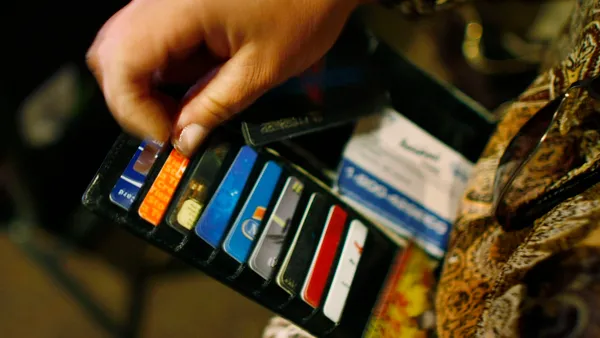Dive Brief:
- Young people are more likely to experience fraud and scams than their older counterparts because of the way they use the internet and send money, according to a survey from marketing research firm J.D. Power.
- Bank customers under 40 years old send money to scammers over peer-to-peer networks, or use credit cards to pay scammers, more often than older people, firm found in a survey of 22,982 account holders. The survey, released on Nov. 7, was fielded between March and September.
- The survey results showed 29% of bank customers experienced fraud or scams, based on responses about account use in the past 12 months. But for bank customers under 40 years old, that figure was a higher 42%, according to the results. "Debit card fraud and peer-to-peer transfer issues, that's what makes the younger population more at risk," said Jennifer White, senior director of banking and payments intelligence for J.D. Power.
Dive Insight:
The survey included responses from customers at 32 financial institutions, including American Express, Barlays, JPMorgan Chase, Goldman Sachs and Wells Fargo, among others, J.D. Power said.
U.S. consumers lost $2.7 billion to impostor scams in 2023, roughly the same amount that was lost in 2022, but that figure was up from $2.1 billion in 2021. Regulators and lawmakers have singled out peer-to-peer payments platforms like Zelle — which is owned and operated by seven large banks — as the facilitators of such scams.
In an impostor scam, a bad actor strikes up a professional or romantic relationship with an unsuspecting consumer and persuades that person to send money, often through peer-to-peer platforms. Fraud, on the other hand, is when a bad actor takes over someone’s credit card or bank account and steals money or makes unauthorized purchases.
Zelle’s bank owners at parent Early Warning Services have pushed back against criticism of the platform, noting that the company flags suspicious transactions and warns customers of potential scams.
While conventional wisdom says that older people are more likely to be victims of fraud or impostor scams, they are less likely to use platforms like Zelle or shop online with debit or credit cards than younger people, White said.
Among survey respondents under 40-years-old, 17% said they had sent money to a scammer and 10% said they bought something from a scammer with their credit card. Those figures were 7% and 5%, respectively, for respondents between the ages of 40 and 64, and 2% and 5% for those 65 and older, J.D. Power’s survey found.
In another counter-intuitive discovery, the survey found that 46% of bank customers and 49% of credit card users have a higher opinion of their financial institutions after experiencing fraud.
The reasons are relatively straight-forward, White said. For example, banks are simply not high on the list of people consumers blame when a scammer or fraudster takes their money.
"We did ask who they blame for fraud, and the number one answer is the bad actor," White said.
In fact, nearly half (42%) of bank customers surveyed said that the fraudster or scammer is the person most to blame for a fraudulent transaction, with the merchant (17%) coming in a distant second, followed by “don’t know” (16%) and then “myself” (15%). A mere 12% of bank customers said their financial institution bore the most blame, the survey found.
Banks also reimburse victims of credit and debit card fraud — as required by law — she said, and financial institutions are becoming more adept at spotting fraudulent exchanges and flagging them.
J.D. Power’s findings — that nearly half of survey respondents have an improved opinion of their bank after experiencing fraud — signal that banks are doing a good job handling scams and fraud at least half the time, White said.
"If you handle a bad event well, you can generally get more loyalty from the customers than if the transaction with the customer was routine," she said











